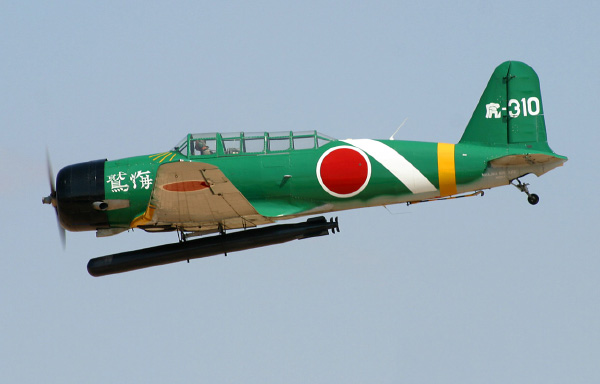
|
 |
Nakajima B5N (Kate) |
 |
 |
 |
 |
 |
|---|---|---|---|---|---|---|---|
 |
 |
 |
 |
 |
|||
 |
|||
|
Codenamed Kate by the Allies, the Nakajima B5N was already in service for four years by 1941, and was the most modern carrier-based torpedo bomber at the beginning of WWII. It was superior to its Allied counterparts, the TBD Devastator, Fairey Swordfish and Fairey Albacore, and the B5N supported amphibious operations throughout the war. It delivered fatal blows to three US Navy Carriers, the Lexington, the Yorktown and the Hornet. On December 7, 1941, the Japanese Imperial Navy launched 353 aircraft from six carriers in a surprise attack, against US military installations, that crippled the US Navy Fleet at Pearl Harbor. The attack force included 144 Nakajima B5Ns, 129 Aichi D3As and 80 Mitsubishi A6M2s.1 | |||
| Designed to a 1935 requirement, the B5N had a crew of three: pilot, radio operator/gunner, and navigator/bombardier/observer. It was a low-wing monoplane with inwards-retracting wide-track landing gear that was exceptionally clean, and was powered by a Nakajima Hikan radial engine. It first flew in January 1937, and the following year production B5N1 aircraft were embarking in Japan's carriers and shore-based units were deployed in China. |
| In 1939, the improved B5N2 appeared with a more powerful Sakae 11 engine in a smaller cowling. Although armament and bombload were unchanged, this version remained in production until 1943. When Japan attacked the USA, the B5N2 had wholly replaced the B5N1 with operational units. However, with its puny defensive armament of a single machine-gun and laden with a large bomb or torpedo, the B5N began to suffer very heavily. Although the type was fully committed during the Solomons campaign, the survivors were withdrawn from combat after the Philippine battles of 1944. Thereafter, on account of their excellent range, they were assigned to antisubmarine and maritime reconnaissance duties in areas beyond the range of Allied fighters. Production of all B5Ns reached 1,149. The B5N was replaced by the B6N. |
| Specifications: | ||
|---|---|---|
| B5N1 | B5N2 | |
| Dimensions: | ||
| Wing span: | 50 ft 10-15/16 in (15.518 m) | 50 ft 10-15/16 in (15.518 m) |
| Length: | 33 ft 9-1/2 in (10.30 m) | 33 ft 9-1/2 in (10.30 m) |
| Height: | 12 ft 1-21/32 in (3.70 m) | 12 ft 1-21/32 in (3.70 m) |
| Weights: | ||
| Empty: | 4,643 lb. (2,106 kg) | 5,024 lb. (2,279 kg) |
| Loaded: | 8,157 lb (3,700 kg) | 8,378 lb (3,800 kg) |
| Performance: | ||
| Maximum Speed: |
229 mph (199 kt) @ 6,560 ft (2,000 m) |
235 mph (204 kt) @ 11,810 ft (3,600 m) |
| Service Ceiling: | 24,280 ft. (7,400 m) | 27,100 ft. (8,260 m) |
| Normal Range: | 679 st miles (1,092 km) | 608 st miles (978 km) |
| Max. Range: | 1,404 st miles (2,259 km) | 1,237 st miles (1,990 km) |
| Powerplant B5N1: | Powerplant B5N2: |
|---|---|
|
Nakajima Hikari 3, 770 hp, 9 cylinder, air-cooled radial engine. |
Nakajima NK 1B Sakae 11, 1,000 hp, 14 cylinder, air-cooled radial engine. |
| Armament: | |
|
One flexible rear-firing 7.7 mm Type 92 machine gun. 800 kg (1,764 lb) of bombs, or one 800 kg (1,764 lb) torpedo. | |
Endnotes
|
1. Rene J. Francillon, Japanese Aircraft of the Pacific War, Aichi D3A. Annapolis, Maryland: Naval Institute Press, 1995. 411. |
©Larry Dwyer. The Aviation History On-Line Museum.
All rights reserved.
Created April 25, 2011. Updated November 5, 2013.